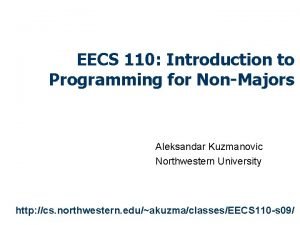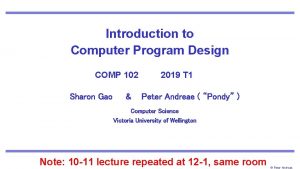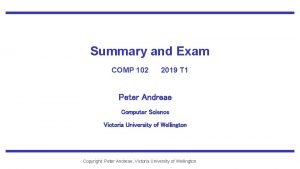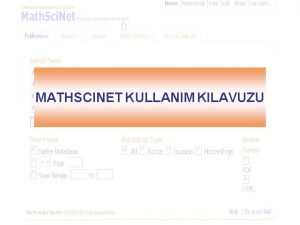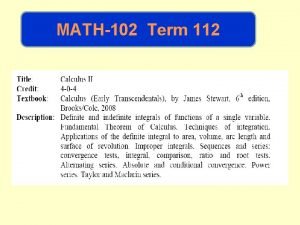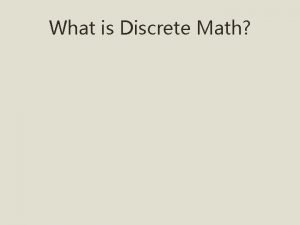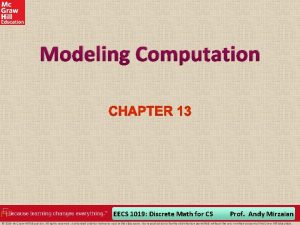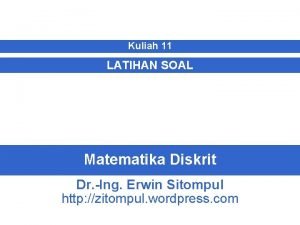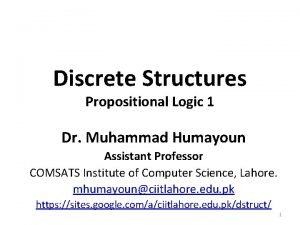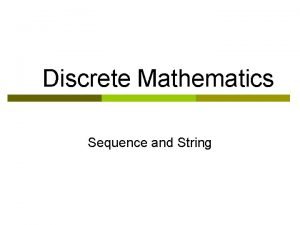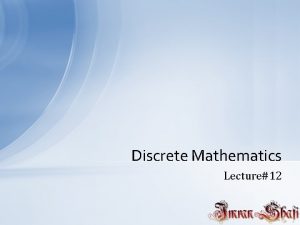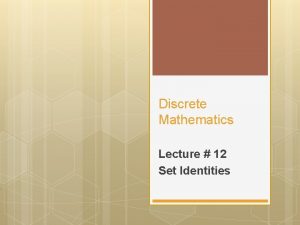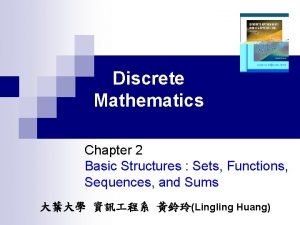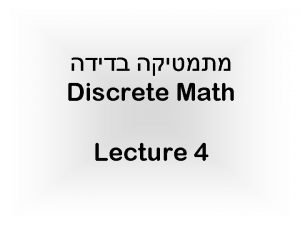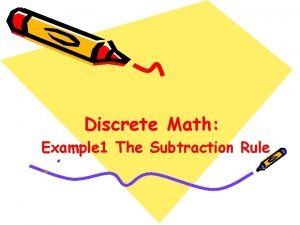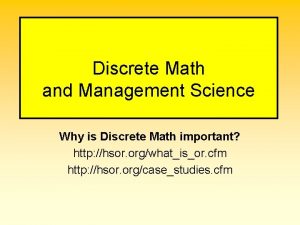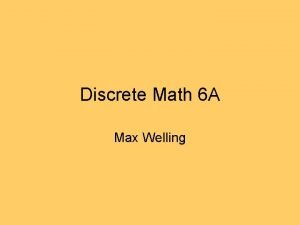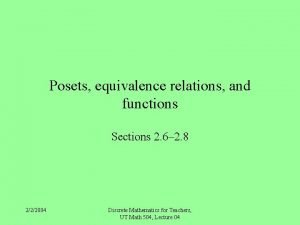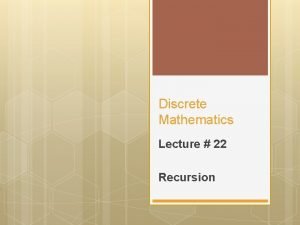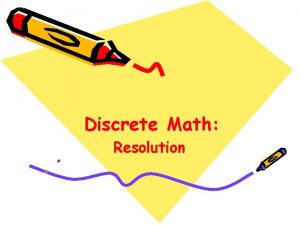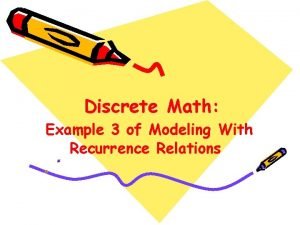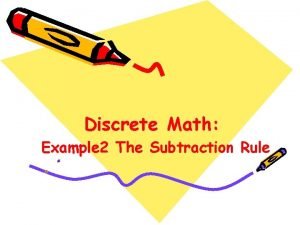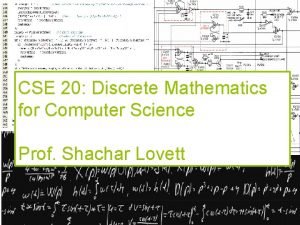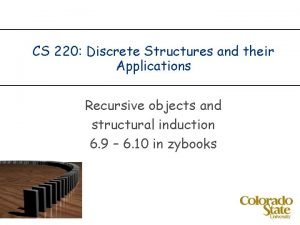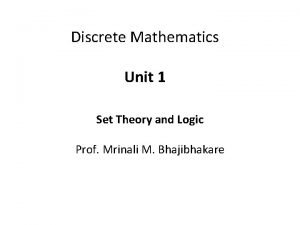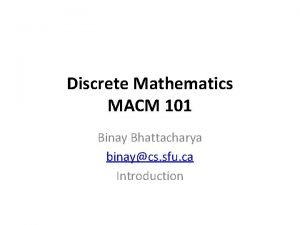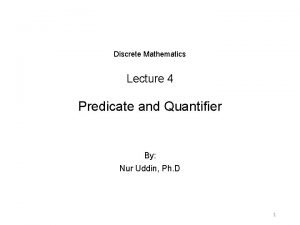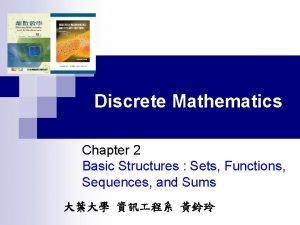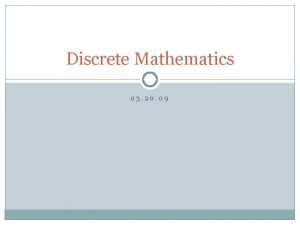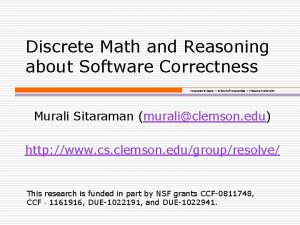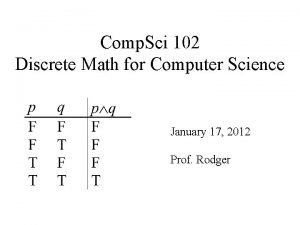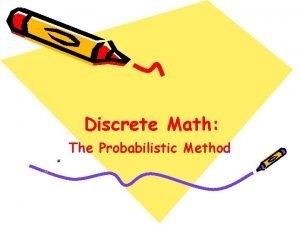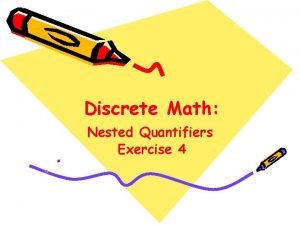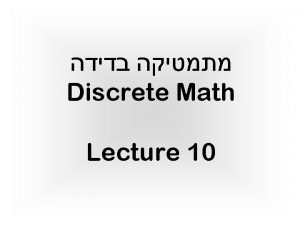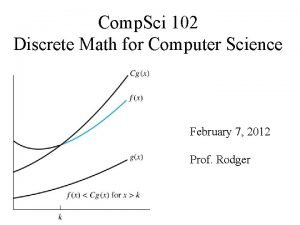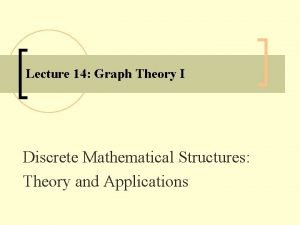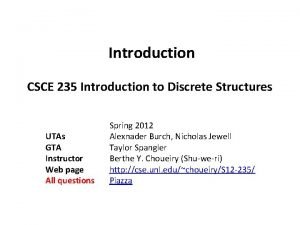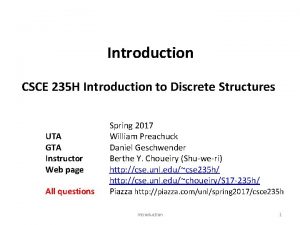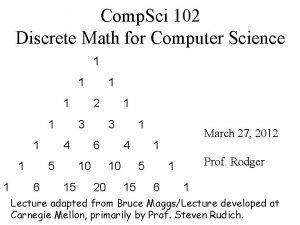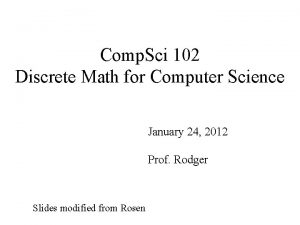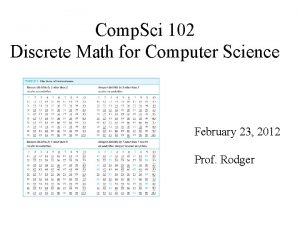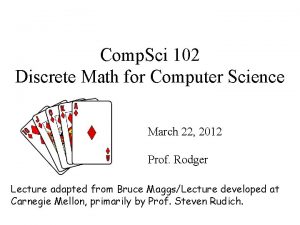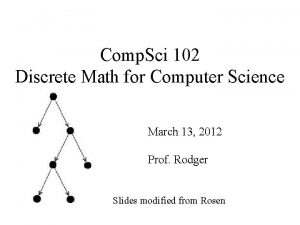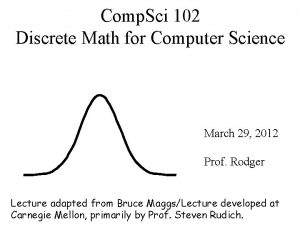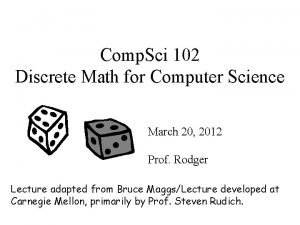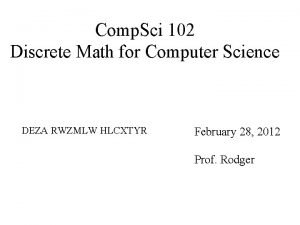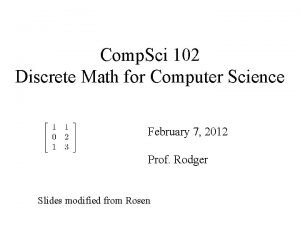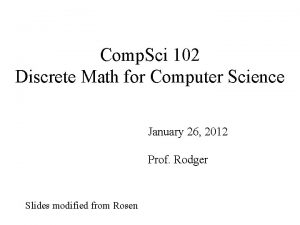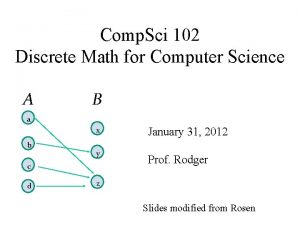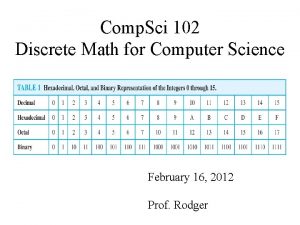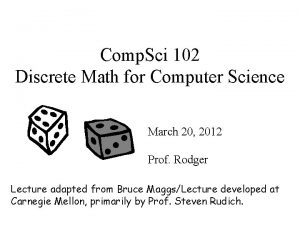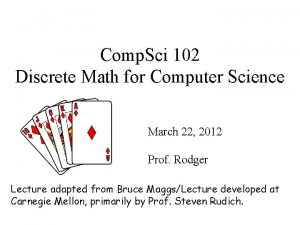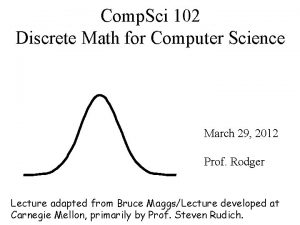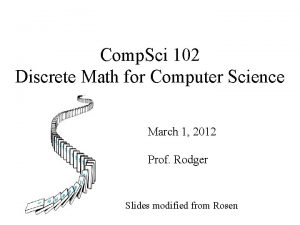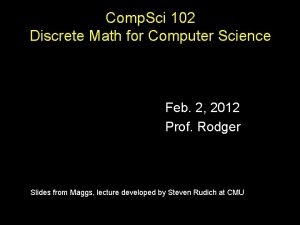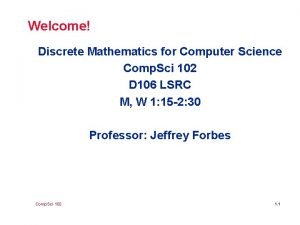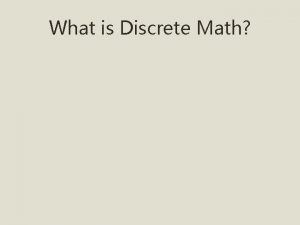Comp Sci 102 Discrete Math for Computer Science


















































- Slides: 50

Comp. Sci 102 Discrete Math for Computer Science 1 1 1 1 2 3 4 5 6 1 3 6 10 15 1 1 4 10 20 1 5 15 March 27, 2012 Prof. Rodger 1 6 1 Lecture adapted from Bruce Maggs/Lecture developed at Carnegie Mellon, primarily by Prof. Steven Rudich.

Announcements • More on Counting

Counting III 1 X+ 2 X+ 3 X

Power Series Representation n (1+X)n = k=0 “Product form” or “Generating form” = k=0 n k Xk Xk For k>n, n k “Power Series” or “Taylor Series” Expansion =0

By playing these two representations against each other we obtain a new representation of a previous insight: n (1+X)n = k=0 n Let x = 1, 2 n = k=0 n k Xk n k The number of subsets of an n-element set

Example 4 0 4 1 4 2 24 4 3 4 4 = 16 Number of subsets of size 0, size 1, size 2, size 3, and size 4

By varying x, we can discover new identities: n (1+X)n = k=0 n Let x = -1, 0= k=0 n Equivalently, k odd n k Xk n (-1)k k n = k even n k

The number of subsets with even size is the same as the number of subsets with odd size

n (1+X)n = k=0 n k Xk Proofs that work by manipulating algebraic forms are called “algebraic” arguments. Proofs that build a bijection are called “combinatorial” arguments

n k odd n k n = k even n k Let On be the set of binary strings of length n with an odd number of ones. Let En be the set of binary strings of length n with an even number of ones. We gave an algebraic proof that On = En

A Combinatorial Proof Let On be the set of binary strings of length n with an odd number of ones Let En be the set of binary strings of length n with an even number of ones A combinatorial proof must construct a bijection between On and En

An Attempt at a Bijection Let fn be the function that takes an n-bit string and flips all its bits fn is clearly a one-to-one and onto function for odd n. E. g. in f 7 we have: . . . but do even n work? In f 6 we have 0010011 1101100 1001101 0110010 110011 001100 101010 010101 Uh oh. Complementing maps evens to evens!

A Correspondence That Works for all n Let fn be the function that takes an n-bit string and flips only the first bit. For example, 0010011 101001101 0001101 110011 010011 101010 001010

n (1+X)n = k=0 n k Xk The binomial coefficients have so many representations that many fundamental mathematical identities emerge…

The Binomial Formula (1+X)0 = 1 (1+X)1 = 1 + 1 X (1+X)2 = 1 + 2 X + 1 X 2 (1+X)3 = 1 + 3 X 2 + 1 X 3 (1+X)4 = 1 + 4 X + 6 X 2 + 4 X 3 + 1 X 4 Pascal’s Triangle: kth row are coefficients of (1+X)k Inductive definition of kth entry of nth row: Pascal(n, 0) = Pascal (n, n) = 1; Pascal(n, k) = Pascal(n-1, k-1) + Pascal(n-1, k)

“Pascal’s Triangle” 0 =1 0 1 =1 0 2 =1 0 3 =1 0 1 =1 1 2 =2 1 3 =3 1 2 =1 2 3 =3 2 • Al-Karaji, Baghdad 953 -1029 • Chu Shin-Chieh 1303 • Blaise Pascal 1654 3 =1 3

Pascal’s Triangle “It is extraordinary 1 how fertile in properties the 1 1 triangle is. 1 2 1 Everyone can try his 1 3 3 1 hand” 1 4 6 4 1 1 1 5 6 10 15 10 20 5 15 1 6 1

Summing the Rows n 2 n = n k 1 =1 1 + 1 =2 1 + 2 + 1 =4 1 + 3 + 1 =8 1 + 4 + 6 + 4 + 1 = 16 1 + 5 + 10 + 5 + 1 = 32 1 + 6 + 15 + 20 + 15 + 6 + 1 = 64 k=0

Odds and Evens 1 1 1 1 2 3 4 5 6 1 3 6 10 15 1 1 4 10 20 1 5 15 1 6 1 + 15 + 1 = 6 + 20 + 6 1

Summing on 1 st Avenue n 1 1 1 1 2 3 4 5 6 1 15 1 4 10 1 5 15 1 6 i=1 1 6 20 i = i=1 3 10 n 1 i = n+1 2 1

Summing on kth Avenue 1 1 1 1 6 2 4 6 1 4 10 20 i=k 1 3 10 15 1 3 5 n 1 5 15 1 6 1 i = n+1 k

Fibonacci Numbers 1 =2 1 1 =3 = 5 1 2 1 =8 1 3 3 1 = 13 1 1 1 4 5 6 6 10 15 4 10 20 1 5 15 1 6 1

Sums of Squares 1 1 1 1 2 2 2 3 2 2 4 5 6 1 3 2 6 10 15 1 2 1 4 10 20 2 1 5 15 1 6 1

Al-Karaji Squares 1 1 =1 2 +2 1 =4 1 1 3 +2 3 1 1 4 +2 6 5 +2 10 6 +2 15 4 10 20 =9 1 5 15 = 16 1 1 6 = 25 1 = 36

Pascal Mod 2

All these properties can be proved inductively and algebraically. We will give combinatorial proofs using the Manhattan block walking representation of binomial coefficients

How many shortest routes from A to B? A B 10 5

Manhattan jth street 4 There are j+k k 3 2 1 0 0 1 2 kth avenue 3 4 shortest routes from (0, 0) to (j, k)

Manhattan Example jth street 4 3 2 1 0 0 1 2 kth avenue 3 4 2 cd street, 3 rd ave j+k k = 5 3 6 points on that row, this is the 4 th binomial coefficient of 6 items

Manhattan Level n 4 There are 3 2 n k 1 0 0 1 2 kth avenue 3 4 shortest routes from (0, 0) to (n-k, k)

Manhattan Level n 4 3 2 1 0 0 1 2 kth avenue 3 4 Example: Level 4, 3 rd avenue 4 3 There are n k shortest routes from (0, 0) to level n and kth avenue

Level n 4 3 2 1 1 1 6 0 0 1 5 1 1 4 1 3 2 6 1 3 1 1 4 2 kth avenue 3 1 4 1 1 10 10 5 15 20 15 6

Level n 4 3 2 1 0 1 kth avenue 1 1 1 3 2 1 3 1 1 4 1 6 1 1 5 10 + 10 5 6 15 20 15 6 1 n k 4 n-1 = + k-1 k

Level n 4 n k=0 3 n k 2 1 2 = 0 0 2 n n 1 2 kth avenue 3 4 Example: Show for n=3

Show for n=3 2 3 3 + 1 0 12 20 + 32 2 2 3 3 3 + + 2 + 32 + 2 = 12 6 3 =

Level n 4 3 2 1 0 0 1 2 kth avenue 3 4 Show for k=2, n=5 n i=k i k n+1 = k+1

Show for k=2, n=5 3 2 + 2 2 1 + 3 4 5 + + 2 2 + 6 3 = 10 = 20

Vector Programs Let’s define a (parallel) programming language called VECTOR that operates on possibly infinite vectors of numbers. Each variable V! can be thought of as: < * , * , *, *, … >

Vector Programs Let k stand for a scalar constant <k> will stand for the vector <k, 0, 0, 0, …> <0> = <0, 0, …> <1> = <1, 0, 0, 0, …> V! + T! means to add the vectors position-wise <4, 2, 3, …> + <5, 1, 1, …. > = <9, 3, 4, …>

Vector Programs RIGHT(V!) means to shift every number in V! one position to the right and to place a 0 in position 0 RIGHT( <1, 2, 3, …> ) = <0, 1, 2, 3, …>

Vector Programs Example: Store: V! : = <6>; V! : = RIGHT(V!) + <42>; V! : = RIGHT(V!) + <13>; V! = <6, 0, 0, 0, …> V! = <42, 6, 0, 0, …> V! = <2, 42, 6, 0, …> V!= <13, 2, 42, 6, …> V! = < 13, 2, 42, 6, 0, 0, 0, … >

Vector Programs Example: Store: V! : = <1>; V! = <1, 0, 0, 0, …> V! = <1, 1, 0, 0, …> V! = <1, 2, 1, 0, …> V!= <1, 3, 3, 1, …> Loop n times V! : = V! + RIGHT(V!); V! = nth row of Pascal’s triangle

1 X + 2 X + Vector programs can be implemented by polynomials! 3 X

Programs Polynomials The vector V! = < a 0, a 1, a 2, . . . > will be represented by the polynomial: PV = i=0 a i. X i

Formal Power Series The vector V! = < a 0, a 1, a 2, . . . > will be represented by the formal power series: PV = i=0 a i. X i

V ! = < a 0, a 1, a 2, . . . > PV = a i. X i i=0 <0> is represented by 0 <k> is represented by k V! + T! is represented by RIGHT(V!) is represented by (PV + PT) (PV X)

Vector Programs Example: V! : = <1>; PV : = 1; Loop n times V! : = V! + RIGHT(V!); PV : = PV + PV X; V! = nth row of Pascal’s triangle

Vector Programs Example: V! : = <1>; PV : = 1; Loop n times V! : = V! + RIGHT(V!); PV : = PV(1+X); V! = nth row of Pascal’s triangle

Vector Programs Example: V! : = <1>; Loop n times V! : = V! + RIGHT(V!); PV = (1+ X)n V! = nth row of Pascal’s triangle

• Polynomials count • Binomial formula • Combinatorial proofs of binomial identities • Vector programs Here’s What You Need to Know…
 Apcsa recursion
Apcsa recursion Comp sci 110 northwestern
Comp sci 110 northwestern Comp sci 1102
Comp sci 1102 Comp sci 1027
Comp sci 1027 Zjhz
Zjhz Comp 102
Comp 102 Comp 102
Comp 102 Math sci
Math sci Faisal fairag kfupm
Faisal fairag kfupm Math 102 kfupm
Math 102 kfupm What is her favourite subject
What is her favourite subject What is discrete mathematics
What is discrete mathematics Denying the antecedent fallacy
Denying the antecedent fallacy Modeling computation discrete math
Modeling computation discrete math Logical equivalence in discrete mathematics
Logical equivalence in discrete mathematics Soal matematika kuliah semester 6
Soal matematika kuliah semester 6 Discrete math propositional logic
Discrete math propositional logic Sequence discrete math
Sequence discrete math What is irreflexive relation in discrete mathematics
What is irreflexive relation in discrete mathematics Set identities exercises
Set identities exercises Sets and functions in discrete mathematics
Sets and functions in discrete mathematics Mathematical system
Mathematical system What does onto mean in discrete math
What does onto mean in discrete math Subtraction rule counting
Subtraction rule counting Euler circuit
Euler circuit Nested quantifiers
Nested quantifiers Discrete math susanna epp
Discrete math susanna epp Poset discrete math
Poset discrete math Counterexample discrete math
Counterexample discrete math Recursive definition in discrete mathematics
Recursive definition in discrete mathematics Resolution of a story example
Resolution of a story example Recurrence discrete math
Recurrence discrete math Subtraction rule example
Subtraction rule example Knights and knaves discrete math
Knights and knaves discrete math Structural induction discrete math
Structural induction discrete math Sets and propositions in discrete mathematics
Sets and propositions in discrete mathematics Sfu discrete math
Sfu discrete math Predicate discrete math
Predicate discrete math Sequence discrete math
Sequence discrete math Division algorithm in discrete mathematics
Division algorithm in discrete mathematics Discrete math
Discrete math Discrete mathematics
Discrete mathematics Discrete math tutor
Discrete math tutor Let t(x y) means that student x likes dish y
Let t(x y) means that student x likes dish y Binary relation examples
Binary relation examples Big-o notation discrete math
Big-o notation discrete math Discrete math
Discrete math What is discrete math
What is discrete math Webhandin unl
Webhandin unl What is discrete mathematics
What is discrete mathematics Inverse relation in discrete mathematics
Inverse relation in discrete mathematics

